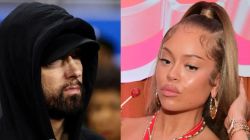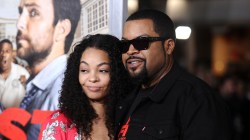For the past month, Waka Flocka Flame has been getting “turnt up” in front of largely EDM-favoring crowds while on tour with Steve Aoki. In April, Waka revealed plans for a full EDM/Hip Hop hybrid album.
“The King of Rap EDM is me,” Waka told HipHopDX. “I’ve been there. Punk Rap, that’s EDM. People didn’t understand what I was saying, now they do. I see a lot of my students, and I’m like the principal. I’m here to talk… [The album’s] already in the motion. Flosstradamus, Diplo, Skrillex. Some underground people, too. I want to create a name. I’ve been doing it in Hip Hop so long.”
As well, 2013 saw collaborations between Daft Punk and Kanye West [West’s Yeezus album], Skrillex and A$AP Rocky [Rocky’s “Wild For The Night”], plus Diplo and well, damn near pretty much everyone. That being said, for those who are afraid that Electronic Dance Music’s influence is going to kill Rap music, you’re absolutely right. It will. It is only because Rap is not at a place where its level of engagement with dance is coming from organic interest or creative growth that this is the case. Hip Hop devolving into an arguably cannibalistic and greed-driven culture will certainly allow for cash-rich EDM to be Rap’s savior, but sadly also provide to be the cause of its ruin. Furthermore, it can be argued that Hip Hop culture could as well leave the soul of Rap and instead become the guiding light of Electronic Dance Music. However, this does not have to be the case. If Rap can find a way to rediscover the intrinsic connection to dance that lies at Hip Hop culture’s core principles, then this sad turn of events can be avoided.
Rock The House: Hip Hop’s Oft-Forgotten Dance Origins
“Just jam sucker (Say jam sucker) / Say groove, sucker (Say groove, sucker) / Say dance, sucker (Say dance, sucker) / Now move, sucker (Now move, sucker).”– Afrika Bambaataa, “Renegades of Funk”

AD LOADING...
Somewhere along the way Rap music has forgotten that 40 years ago, DJ Kool Herc kicked off four decades of Hip Hop culture by deejaying a party that involved *gasp* dancing to records—records that, in many cases were the prototype for what disco was to become—in a basement in the South Bronx. Continuing to extrapolate this story, Rap’s early history involved break-dancing, Afrika Bambaataa sampling new wave records, Hip-House, funky dance breaks at the core of hit records and more. But, at some point, Rap music lost it’s soul, opened its wallets and to borrow a line from a Drake album title, “nothing was the same.”
Finances (or lack thereof) being at the core of Rap and Dance’s awkward partnering is an 800-pound gorilla that in being readily embraced denotes the nature of the times, as well as the devolving music industry. Speaking to the point of why Rap and Dance are pairing with increased frequency, here are a few facts and figures.
In the year 2000, Eminem released the Marshall Mathers LP, an album that the Recording Industry Association of America certified as having sold 10 million copies domestically, with 1.79 million copies sold in its first week alone. Comparatively, in 2013, Eminem’s Marshall Mathers LP 2 sold approximately 793,000 copies during its first release week. Clearly, for an industry once used to Rap albums pushing in the realm of five-plus million albums sold, the democratization of access caused by piracy and downloading has likely caused a shift in ideas insofar as how to sell albums at a similar level.
In 1999, Jay Z’s “Hard Knock Life” tour became the highest grossing Rap tour—to that point—of all time, reportedly selling out shows in 52 cities. As of July 2013—in an era wherein arguably Hip Hop’s cultural footprint is larger than ever before —there are zero Rap tours in the top 100 North American tours of 2013. However, according to Pollstar, the music industry standard for box office statistics, A$AP Rocky was the opener for the North American leg of Rihanna’s “Diamonds World Tour,” which at that point was ranked at the number 11 spot.

AD LOADING...
How Hip Hop Can Benefit From EDM’s Traditional Revenue Streams
By comparison—and though definitely using a different model with similar, yet different income streams—EDM’s 2012 touring numbers were incredible. A 2013 study by Massive Enterprises estimates global dance festival revenue at $4.5 billion dollars. It’s also worth noting that a significant portion of the growth of digital music sales—considered the music industry’s savior—is easily attributable to the digital growth of EDM. I think if Rap music were able to cut into these numbers by even say, 25 percent, the decade-long commercial slide of Rap sales could be stymied. However, if Rap is not able to create its own unique sense of purpose while in the midst of depending upon EDM’s financial largess, it’s entirely possible that Rap could become a subservient slave to the $20 billion EDM beast.
Rap tapping into dance’s traditional revenue streams could radically shift the genre into acquiescing to EDM as well. Traditionally, Rap has been an album-based industry. In fact, I think the music industry’s overall shift from albums to singles with the advent of iTunes and now Pandora and Spotify has disconnected Rap from its traditions, which may be leading to disjointed albums that are not conducive to an enjoyable listening experience.

AD LOADING...
According to a 2012 report by Nielsen, overall album sales finished at $315.96 million, down four percent from $330.57 million in 2011 and back in line with where the industry was heading from 2004 through 2010. A total of 1.336 billion tracks were purchased in 2012, up five percent from 2011’s number of 1.271 billion. In moving from pushing albums to pushing singles, the need for an artist to be uniquely creative versus being catchy enough to have a great hook is entirely apparent.
I think Dance producers are organic to this environment. In many cases, their tracks, which are not as often included as a part of albums, reflect that notion well. Also, Dance’s tradition has often erred toward music being more club than radio ready. Yes, Rap once shared in this ideal; however, when the idea that a song is more lucrative when spun on the radio versus being dropped in a club came into vogue, the split in thinking occurred.
There have been great moments for Rap of late that speak to where Rap can either find distance from, or room to evolve and grow stronger while working alongside EDM in the music industry. Obviously, Kendrick Lamar’s performance on Big Sean’s “Control” was one of those moments where “real Rap” aficionados found themselves nodding their heads, grabbing their backpacks, throwing on some tracks with some dusty-ass samples, and getting to work. Also, there are female performers like Iggy Azalea and Azealia Banks, as well as male rappers Chance the Rapper and Childish Gambino who have made small strides as rappers working with dance tracks. Yet nothing has emerged of yet that resembles getting back to the Jungle Brothers’ “Girl I’ll House You” or “Rapper’s Delight”—Rap’s initial mainstream moment that was of course, backed by Chic’s Disco hit “Good Times.”
Hopes For An Organic Symbiotic Relationship Between EDM & Hip Hop
“What a way to go out, no clout is what the fans will shout / Cause you got gassed and took the wrong route / Came on the scene, chillin’, freakin’ a funky dope line / But when they finish wit you (beep) flatline…” -EPMD “Crossover.”

AD LOADING...
Somewhere in Rap arguably being too staid and greedy to relax, jam, groove, dance and move, the space exists for Hip Hop culture and Rap music’s divergence. Just Blaze, who has embarked upon a recent tour with EDM DJ Baauer, shares this notion.
“When I was a teenager, things were very much in a box, and they were very much compartmentalized,” Just Blaze told HipHopDX. “You were either into Hip Hop or you were into Techno, or you were into Deep House, or you were into Heavy Metal. Whatever music you identified with, that’s what you represented. And I feel like these days, those boundaries aren’t there anymore. You pick up someone from the younger generation’s iPods or whatever and see what they’re listening to, and you see Daft Punk or Justice, but also Kendrick Lamar or J. Cole, and Florence And The Machine. It’s cool to be different and to have different influences now, and that’s something that I’ve always wished for because that’s how I came up—with a little bit of everything.”
I think that if Rap and Dance are to work together, the relationship must again become symbiotic, organic and truly creative in nature. The idea of working with a Dance producer (such as Calvin Harris) must not intrinsically come from a place of noting that he made $50 million dollars in the past year and plays at festivals that gross $5 billion in revenue. Ideally, the space must be nostalgic, resembling something more along the lines of early Arthur Baker and Afrika Bambaataa working together in the ‘80s on the aforementioned “Renegades Of Funk.” Created to connect “people with their own philosophies, the people who make history and everyday people like you and me,” if there was actually any commercial impetus behind the song it came from each side of the table wanting to work with each other to equally push their interests to similar degree of exposure.
A seemingly inevitable reality that we should consider accepting is that when the moment comes that Rap cedes to Dance (and all indicators from a culture that from a democratic standpoint is far more commerce driven than art-led that this will be the case), and Hip Hop culture is actively guiding what Electronic Dance Music is to become. When this happens, the one great hope we should all have is that EDM’s lowest hanging fruit—underground producers of non-mainstreamed sounds—can reach out to the Rap industry which would be positioned at the bottom of EDM, and the two can find a middle ground. If we want to again discover that organic essence that fueled what Rap music became before commercialism and greed reared their ugly heads, that would be the most likely location for that necessary discovery.

AD LOADING...
The relationship between Rap and EDM at the moment should be a delicately handled situation. Unfortunately, this is not the case. Instead, it comes off more like the relationship between the Titanic and the iceberg, as Rap—which fallaciously still may believe itself to be an unstoppable force—hits growing in commercial strength EDM, with Rap having the potential of sinking into the depths. Of course, as with all things, this could be avoided as an ounce of prevention is worth a pound of cure. But, Rap’s (and most of mainstream music’s for that matter) currently less-than-ideal financial situation may unfortunately be so concerning that it is allowing for not-so-well-formulated stop-gaps to be considered. Rap and dance engaging for the purposes of creating appealing new sounds is an idea that has worth, but is a notion that should only be approached from the standpoint of art over commerce, or else.
Marcus Dowling is a veteran Washington, DC-based writer who has contributed to a plethora of online and print magazines and newspapers over the past fifteen years. Follow him on Twitter at @marcuskdowling.



